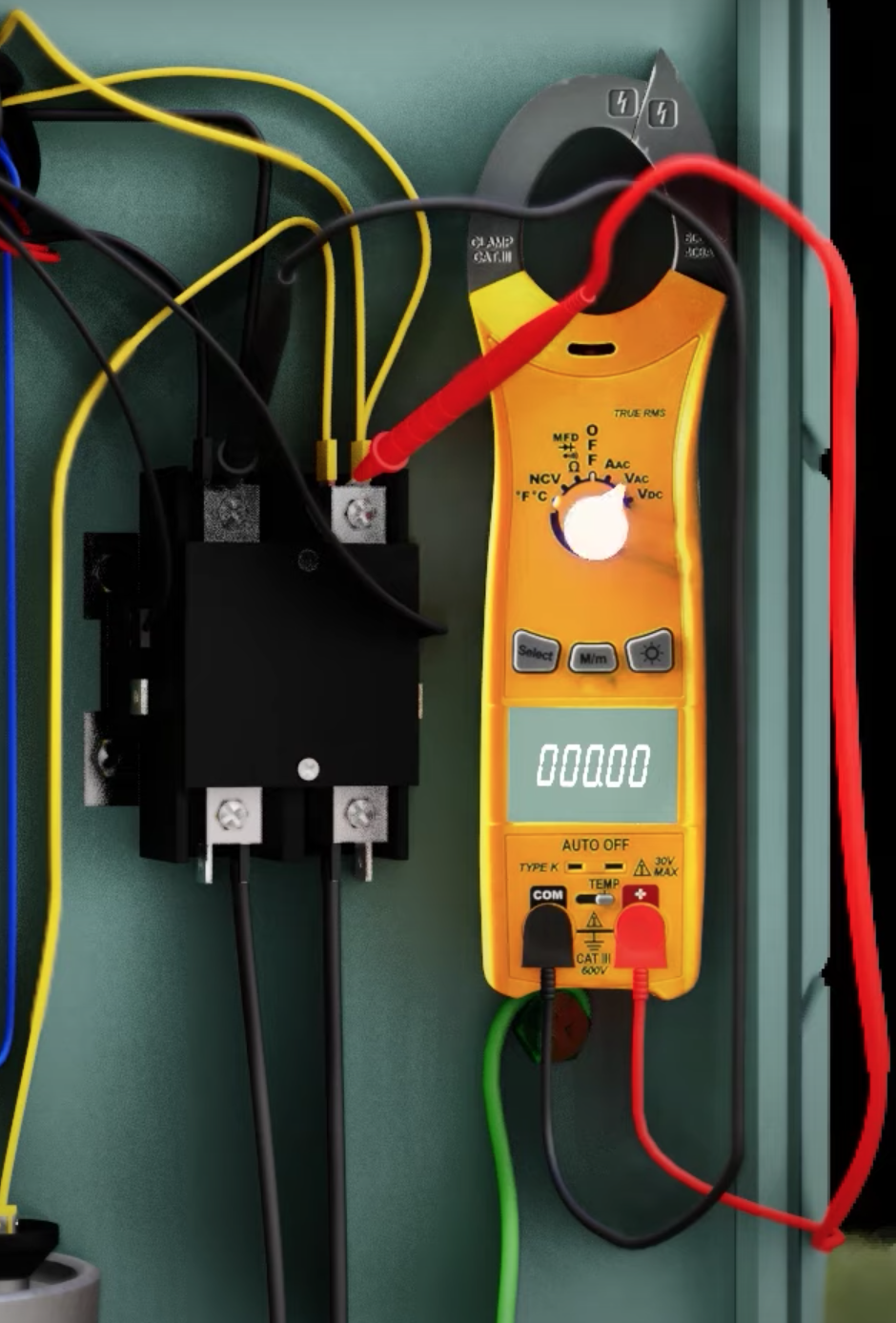Get Tech Tips
Subscribe to free tech tips.
Understanding 240-Volt Circuits
It can be useful to think of a multimeter as a “voltage drop” tool. Bryan covers the concept here in an excellent class that I highly recommend. This concept was a big help to me as I began to truly learn how to use a multimeter.
A meter reads the voltage differential between two points. If both of those points have voltage and it happens to be the same amount of voltage, you will read 0 volts. So, because there is no difference in voltage, the multimeter will tell you that there is no voltage drop.
A great way to see this in action is to check the voltage across a switch, like a limit switch on a furnace. The control board sends 24 volts through the limit circuit at all times while running, and when functioning properly, a limit switch is “closed,” meaning power passes through it. If you check across the limit switch while the heat is running and the limit switch is closed, you will read 0 volts, even though power is present.

If the limit switch opens up, you will read 24 volts across the switch. Did the amount of voltage actually change? No. What changed was the differential across the switch, which is what your meter is able to detect.
Let’s discuss this specifically in the context of condensers, where misdiagnosis and electrocution are possible if we don’t understand a few things and how to use our tools correctly. This is complicated additionally by the fact that we are dealing with 240-volt single-phase power (so 2 legs of 120 that are 180 degrees out of phase with each other.)
How 240-volt single-phase power works
240-volt single-phase can be very confusing. The picture below shows how it works. You have 2 legs of 120-volt power that come from a center tapped transformer. Here’s a great video of basic electrical theory that helps explain alternating current.
The most important thing to know is that because these two legs are out of phase with each other, they are able to use each other as pathways to complete their electrical circuits. On a 120-volt circuit, there is a dedicated neutral wire, and we have a “common” on 24-volt circuits, but we don’t need a common or neutral on 240-volt circuits because each leg uses the other as a common.
On an air conditioner condenser, all the electronic components are 240 volts. Some other household appliances use a mix of 240 and 120, so they have a neutral wire running to them as well. The 120-volt components use 1 hot leg and the neutral. The 240-volt components use both hot legs.

Again, let’s think back to what a meter is actually reading. If you check each leg of a 240-volt residential circuit to ground, you will read 120 volts. It is the differential between +120 and -120 that gives you 240 volts when you check leg to leg on a contactor at a condenser… except when you don’t.
“Losing a leg”
If you’ve been in the trade long enough, you’ve probably heard someone say, “We lost a leg somewhere.” What are they talking about?

In this scenario, you have lost a leg of 120-volt power somewhere before the location you are checking for voltage. In the case of HVAC, we are often checking the voltage in the equipment, so the most common place to “lose a leg” is either at the service disconnect or the breaker panel.
If you lose a leg of power, what will you read with your meter at the contactor where we typically check for high voltage? You may read 120. Or, more likely, you will read 0 leg to leg. Here’s why:

The leg of 120 volts that is still live enters on one side of the contactor. If your contactor is closed (meaning you have a call for cool), the voltage travels through the circuits in the motor and compressor and back out the other side of the contactor—just as it normally does.
But nothing runs on the condenser because the other leg of 120-volt power (which has a dual use of providing power and a neutral path for the other leg) has been broken. So, you are measuring 2 points that are electrically the same (your meter will read 0) but is actually a live wire. For this reason, I always check both legs to ground as a safety precaution and diagnostic step, as it can tell you some really important things about what is going on with the system very quickly.
—Matt Bruner
P.S. – ESCO Group's HVACR Learning Network also has some useful courses related to electrical basics and troubleshooting. Their Electrical Theory and Application course is suitable for people at all stages of their HVAC/R education and can be purchased for $51.95 or included with the All-Access Subscription Bundle (learn more at https://hvacrschool.com/esco-all-access).
You can also watch a FREE webinar about electrical troubleshooting by Dirk Nauman and Clifton Beck. (You can also earn NATE and HVAC Excellence credits by taking a quiz after for $2.99. However, the quiz is FREE with the All-Access Subscription Bundle.)











Comments
The legs are not out of phase with each other.
240V single phase, aka "split phase 240", uses two hot legs, as indicated in the article, one from each power bus from the panel, each one tapped at the farthest ends of the secondary winding in the step-down transformer.
But let's stop there. Think about the primary winding; how many phases are present at the primary? It has two connections, one single voltage drop across it; the primary only has ONE phase (hence the name, "single-phase 240V")! Therefore, the secondary can only possibly produce one single phase to match. The primary coil's phase doesn't magically split itself in two when we tap the center of it's secondary winding..!
The reason we read 120V from each leg to neutral, is because the neutral is the center tap, as indicated in the article. This is simply a confusing reference to measure from since we don't commonly measure anything else this way, from the center out. As this video painstakingly details (https://www.youtube.com/watch?v=uRKbX74lBgU), the misconception of the two legs being out of phase comes from this same confusing (but more convenient way) to measure the voltages from neutral to L1 and L2 on a standard oscilloscope.
Please correct me if I am wrong.
The legs are not out of phase with each other.
240V single phase, aka "split phase 240", uses two hot legs, as indicated in the article, one from each power bus from the panel, each one tapped at the farthest ends of the secondary winding in the step-down transformer.
But let's stop there. Think about the primary winding; how many phases are present at the primary? It has two connections, one single voltage drop across it; the primary only has ONE phase (hence the name, "single-phase 240V")! Therefore, the secondary can only possibly produce one single phase to match. The primary coil's phase doesn't magically split itself in two when we tap the center of it's secondary winding..!
The reason we read 120V from each leg to neutral, is because the neutral is the center tap, as indicated in the article. This is simply a confusing reference to measure from since we don't commonly measure anything else this way, from the center out. As this video painstakingly details (https://www.youtube.com/watch?v=uRKbX74lBgU), the misconception of the two legs being out of phase comes from this same confusing (but more convenient way) to measure the voltages from neutral to L1 and L2 on a standard oscilloscope.
Please correct me if I am wrong.
Benjamin, you are correct. I’ll get the article edited. Thanks for catching that!
Benjamin, you are correct. I’ll get the article edited. Thanks for catching that!
To leave a comment, you need to log in.
Log In